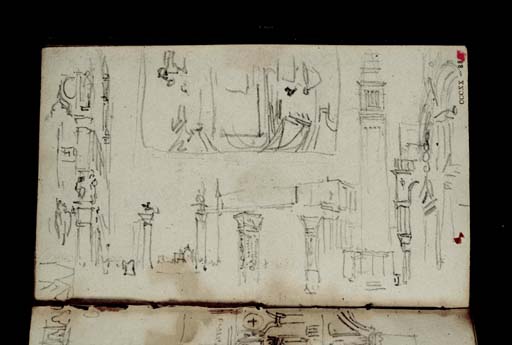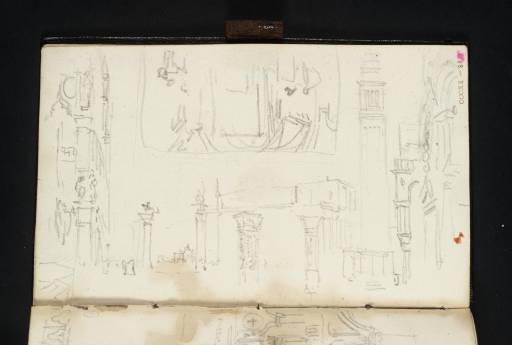Joseph Mallord William Turner The Piazzetta, Venice, from the Palazzo Ducale (Doge's Palace) to the Campanile and Basilica of San Marco (St Marco), with the Pilastri Acritani in the Foreground; the Vault of the Porta della Carta 1840
Image 1 of 2
-
 Joseph Mallord William Turner, The Piazzetta, Venice, from the Palazzo Ducale (Doge's Palace) to the Campanile and Basilica of San Marco (St Marco), with the Pilastri Acritani in the Foreground; the Vault of the Porta della Carta 1840
Joseph Mallord William Turner, The Piazzetta, Venice, from the Palazzo Ducale (Doge's Palace) to the Campanile and Basilica of San Marco (St Marco), with the Pilastri Acritani in the Foreground; the Vault of the Porta della Carta 1840 -
 Joseph Mallord William Turner, The Piazzetta, Venice, from the Palazzo Ducale (Doge's Palace) to the Campanile and Basilica of San Marco (St Marco), with the Pilastri Acritani in the Foreground; the Vault of the Porta della Carta 1840 (Enhanced image)Enhanced image
Joseph Mallord William Turner, The Piazzetta, Venice, from the Palazzo Ducale (Doge's Palace) to the Campanile and Basilica of San Marco (St Marco), with the Pilastri Acritani in the Foreground; the Vault of the Porta della Carta 1840 (Enhanced image)Enhanced image
Joseph Mallord William Turner,
The Piazzetta, Venice, from the Palazzo Ducale (Doge's Palace) to the Campanile and Basilica of San Marco (St Marco), with the Pilastri Acritani in the Foreground; the Vault of the Porta della Carta
1840
Joseph Mallord William Turner 1775–1851
Folio 88 Recto:
The Piazzetta, Venice, from the Palazzo Ducale (Doge’s Palace) to the Campanile and Basilica of San Marco (St Marco), with the Pilastri Acritani in the Foreground; the Vault of the Porta della Carta 1840
D32435
Turner Bequest CCCXX 88
Turner Bequest CCCXX 88
Pencil on white wove paper, 89 x 149 mm
Partial watermark ‘J H’
Inscribed by John Ruskin in red ink ‘88’ top right, ascending vertically
Stamped in black ‘CCCXX – 88’ top right, ascending vertically
Partial watermark ‘J H’
Inscribed by John Ruskin in red ink ‘88’ top right, ascending vertically
Stamped in black ‘CCCXX – 88’ top right, ascending vertically
Accepted by the nation as part of the Turner Bequest 1856
Exhibition history
2003
Turner and Venice, Tate Britain, London, October 2003–January 2004, Kimbell Art Museum, Fort Worth, February–May 2004, Museo Correr, Venice, September 2004–January 2005, Fundació ”la Caixa”, Barcelona, March–June 2005 (81, as ‘“Rotterdam to Venice” sketchbook | The Porta della Carta of the Doge’s Palace; and various views of the Piazzetta’, 1840, reproduced in colour; exhibited in London only).
References
1909
A.J. Finberg, A Complete Inventory of the Drawings of the Turner Bequest, London 1909, vol.II, p.1033, CCCXX 88, as ‘Campanile, &c.’.
1930
A.J. Finberg, In Venice with Turner, London 1930, p.170, as ‘Piazzetta from S. Mark’s, with the two pillars in the foreground; and an interior’.
1985
Lindsay Stainton, Turner’s Venice, London 1985, p.50 under no.30.
2003
Ian Warrell in Warrell, David Laven, Jan Morris and others, Turner and Venice, exhibition catalogue, Tate Britain, London 2003, pp.92, 271 no.81, as ‘“Rotterdam to Venice” sketchbook | The Porta della Carta of the Doge’s Palace; and various views of the Piazzetta’, 1840, fig.116 (colour).
Finberg later annotated his 1909 basic Inventory entry (‘Campanile, &c.’): ‘Piazzetta from St. Marks: 2 pillars on foregd. Scaffolding on Campanile’.1 He marked another copy: ‘Doge’s Pal. 2 cols Molo. 2 cols. [...] Campl. ?from St Marks’.2 The Turner scholar C.F. Bell noted in another copy: ‘Scaffolding on Campanile’.3 Finberg also subsequently noted the presence of ‘an interior’.4 Lindsay Stainton has noted the presence of scaffolding round the campanile’s spire, noting this as an important dating tool in such 1840 views;5 see the Introduction to the tour.
With the page turned horizontally, there are two sketches, inverted relative to each other. The main view takes in a very wide prospect, on the left to west-south-west on the right, from a viewpoint near the Porta della Carta of the Palazzo Ducale (Doge’s Palace) and the Basilica of San Marco (St Mark’s). The north-west corner of the palace fames the view on the left, with the west front receding sharply south-south-east down to the Piazzetta’s Molo entrance, with its twin columns overlooking the Bacino; to their right on the opposite side is the Libreria Sansoviniana, leading back to the Loggetta below the towering campanile of St Mark’s in the Piazza, seen to the west-south-west, framed in turn by the south-west corner of the Basilica.
Turner’s novel viewpoint was evidently tucked away in the corner between the inner return of below the Basilica’s treasury and the two free-standing ancient Byzantine pillars known as the Pilastri Acritani in the foreground, formally echoing the much taller columns down the Piazzetta. Compare the detailed study from around the corner of the Basilica in the 1819 Milan to Venice sketchbook (Tate D14394; Turner Bequest CLXXV 42a).
The present view is comparable with that in a contemporary colour study on grey paper (Tate D32204; Turner Bequest CCCXVII 19). There, with the sheet turned upright, attention is focused on the campanile, filling nearly the full height on the right, while the left-hand side is closed off by the corner of the palace, making the perspective effect less extreme. The present drawing does not contain enough detail to have fully informed the watercolour.
In the space left at the top centre, framed by pencil lines, is a study made within the tunnel-like vault of the Porta della Carta, which runs from behind the viewpoint of the main view through to the courtyard of the palace. The view is evidently west to the rectangular doorway facing the Piazzetta, rather than through the Arco Foscari at its other end towards the Scala dei Giganti (Giant’s Staircase), as shown in a contemporary gouache on grey paper (Tate D32181; Turner Bequest CCCXVII 2); the arch and staircase are also seen in separate studies on folios 89 verso and 90 verso (D32438, D32440).
The doorway is shown within the elaborate outer façade of the Porta between the church and palace on folio 87 verso opposite (D32434), with the Pilastri Acritani on the left. In relation to these facing pages, Ian Warrell has observed: ‘one is constantly amazed by the economy with which a few dashes of [Turner’s] pencil created not only instantly recognisable outlines of familiar sights, but how effectively they suggest the ornamental detail on buildings like the Doge’s Palace.’6
Matthew Imms
September 2018
Undated MS note by Finberg (died 1939) in interleaved copy of Finberg 1909, Prints and Drawings Room, Tate Britain, II, opposite p.1033.
Undated MS note by Finberg (died 1939) in copy of Finberg 1909, Prints and Drawings Room, Tate Britain, II, p.1033.
How to cite
Matthew Imms, ‘The Piazzetta, Venice, from the Palazzo Ducale (Doge’s Palace) to the Campanile and Basilica of San Marco (St Marco), with the Pilastri Acritani in the Foreground; the Vault of the Porta della Carta 1840 by Joseph Mallord William Turner’, catalogue entry, September 2018, in David Blayney Brown (ed.), J.M.W. Turner: Sketchbooks, Drawings and Watercolours, Tate Research Publication, December 2019, https://www

